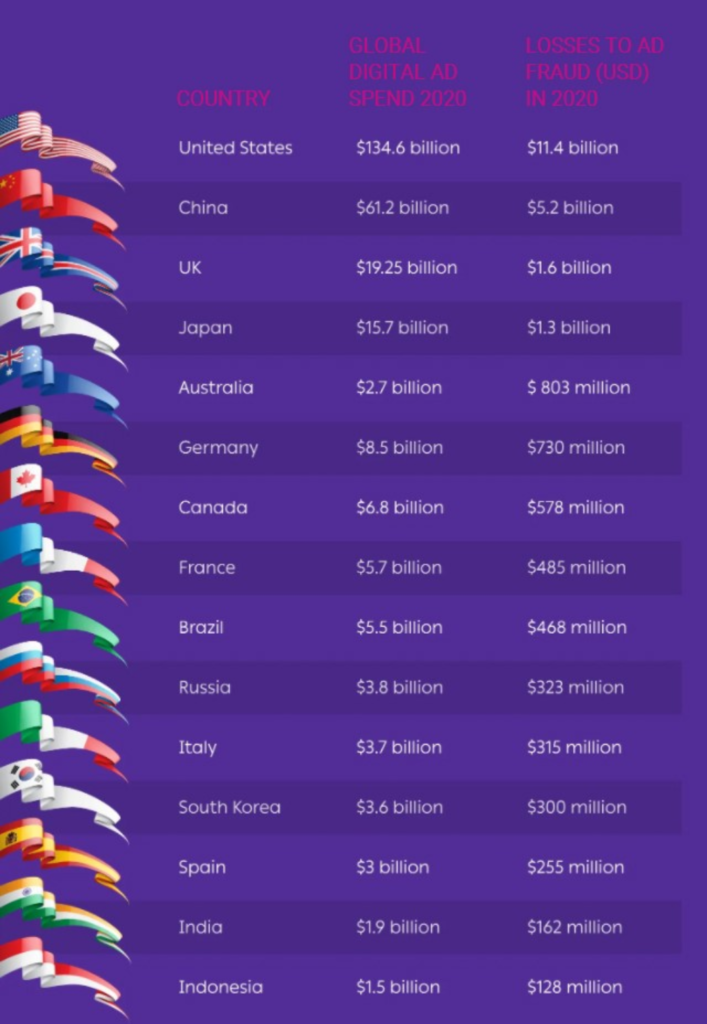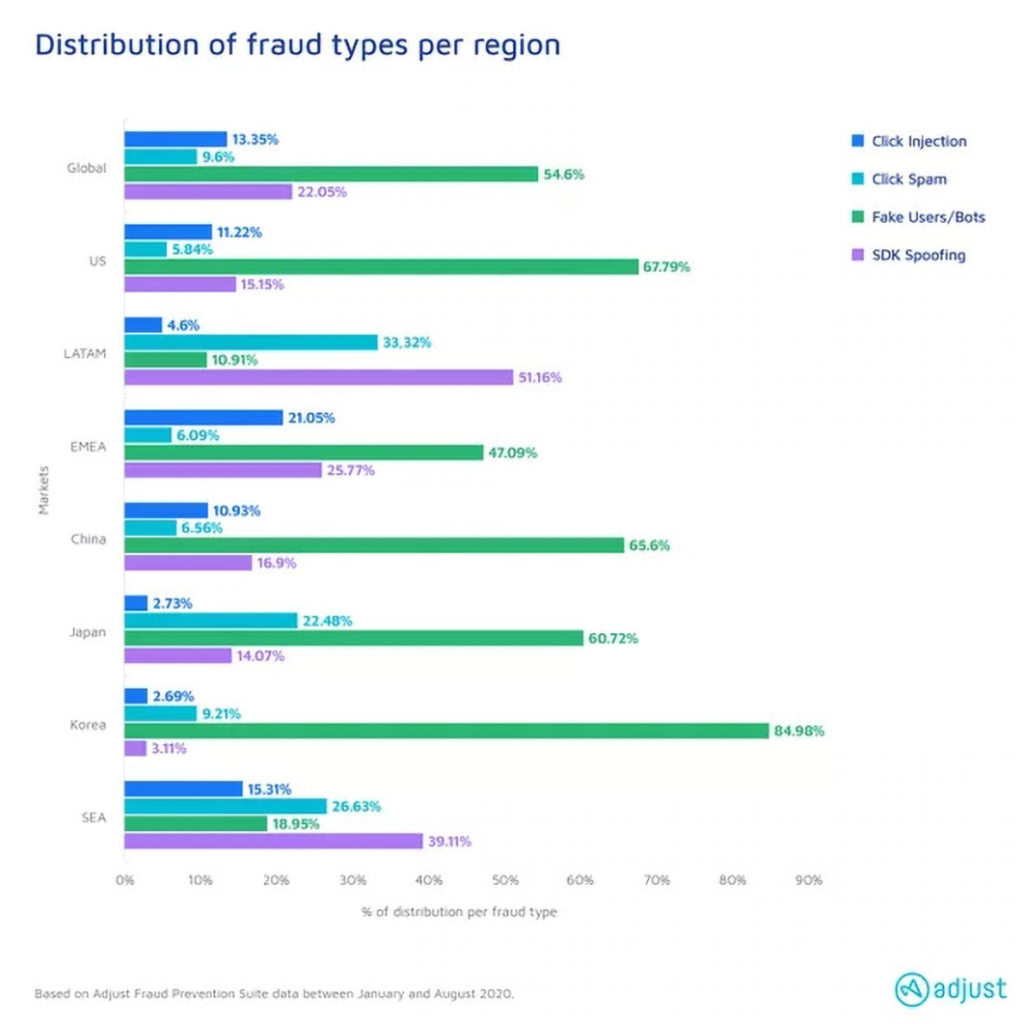The Nasty Mobile Ad Frauds and Effective Ways to Prevent Them
Where advertisers and publishers enjoy the convenience of in-app advertising and mobile app monetization some black sheep love to make their way through. These black sheep have found ways of eating up advertiser’s valuable investments by using various ad frauds. These black sheep are often publishers who tend to suck out the revenue generated with monetization through fraudulent activities.
Global statistics compiled by Statista explain how ad fraud has grown over the years. The year 2020 alone witnessed a loss of 35 billion U.S. Dollars by ad frauds. However, the ratio and volume of fraudulent activity varied from country to country.

The United States of America alone with an advertising market of 333 million U.S. Dollars had to bear a loss of 10% in 2020.

According to the findings by Cheq, we get to see the global digital ad spend of various countries alongside their loss to ad frauds in 2020. From the US, China, UK, Japan, Australia to Indonesia, all countries have been a victim of ad fraud. Ad fraud is not a regional but an industry-wide challenge that requires a solution. As per the findings, United States digital ad spend for 2020 was $134.6 billion out of which $11.4 billion was lost. Next in the line was China with $61.2 billion ad spend out of which $5.2 billion was lost. Now jumping to the countries with lower annual ad spends, India with $1.9 billion ad spend lost $162 million, which is undoubtedly a huge loss. Last in the line, Indonesia with ad spend of $1.5 billion lost $128 million.
As per the ratio and percentage analysis, Indonesia has been a victim of major ad frauds in 2020.
Common Ad Fraud Types that Exist
Various frauds can affect monetization in various ways which lead to advertising campaigns failure. From most common frauds to their prevention, here is all that you need to know:
SDK Spoofing:
This is the most loved and simplest form of fraud that fraudsters often end up doing is SDK spoofing. Fraudsters run multiple fake installs using real devices by hacking SDK and adding code. All these installs and ad impressions help a publisher multiply revenue whereas draining the advertising budget with no real results.
Click Spam:
Also known as organics poaching, in this case, a user is exposed to an ad in reality but the action taken such as clicks is done by a fraudster. This way the fraudsters with fake illegal clicks enjoy the credit for fake actions.
Fake Click:
A fraudster silently installs an android app within your device that monitors activity and reads the install broadcasts. As soon as a new app is downloaded, the fraudster triggers multiple clicks during the time to receive all the installation credit.
These frauds highly affect the results of an advertising campaign while debiting the advertiser’s budget. On the same end, users often face certain frauds such as auto-downloads, auto-redirects, and malware installation, etc. All these sums up to a bad user experience at times.
Distribution of Ad Fraud Types by Region
Adjust has helped us understand how ad fraud trends have been for the year 2020. Click Spam, Click Injection, Fake Users/Bots, and SDK Spoofing collectively have drained the advertising industry’s budget and revenue. The following graph explains how the distribution of ad frauds have been according to various regions.

As per the global findings, 54.6% of fake users and bots added up to ad frauds. Following this was SDK spoofing, then click injections and least damaging was click spam. Analyzing the condition of the United States, fake users and bots were highly damaging in the region, whereas, SDK spoofing followed by. Moving on, it was surprising to see where the world was being affected by fake users at most, the Southeast Asia region had been fighting ad frauds by SDK spoofing at most. Similarly, the LATAM region – Latin America witnessed similar trends where SDK spoofing was more damaging than any. Whereas, the second most damaging ad fraud in both cases was click spam.
Ad frauds collectively have been draining the advertiser’s budget and also damaging the mobile advertising industry for mobile app monetization.
How to Prevent Ad Frauds
Ad frauds can efficiently be fought back by tracking various KPIs – key performance indicators. Each type of ad fraud differently affects the advertising campaigns, however, draining the advertiser’s revenue in similar ways. Following are the few indicators that can help advertisers diagnose whether the fraudulent activity is taking place.
CTIT
The click to install time – CTIT plays an essential role in analyzing what is happening on the side of the publisher. The time between clicks must complement the click to install time. If the number of clicks are relatively high and installs are lower in comparison, you must suspect the publisher for fraudulent activity. This is how click injections are done.
Click Install Frequency
The click install frequency is another important indicator that can help an advertiser understand what is going on. If the frequency of clicks relatively increases in a short period of time in contrast to the general trends, you must further look into the situation. Such a flux in clicks means that there is fraudulent activity from the publisher’s end.
Install to Event Time
Being a mobile advertiser you must always be on your toes to analyze how actions are being taken within your mobile application. If an advertiser witnesses multiple actions within a mobile application in a span of seconds, you know that you are in trouble. This usually happens when SDK spoofing is being done. In the case of SDK spoofing, you get to see multiple actions being taken in an unusually shorter time span.
Event Flow
Another great way to analyze your application for fraud is by looking into the flow of events. If an advertiser gets to see a distorted or abnormal event flow then the SDK is spoofed. The examples include game over event before game sign up or cart check out before selection of a product. These abnormalities in the event flow can make the fraudulent activity evident for the advertiser.
IP Address
Every unique action/click within an advertising campaign must have a unique IP Address. If an advertiser fails to find such a difference within the IP Addresses, then it is evident that fraudulent activity has taken place.
Conclusion
To prevent ad fraud, it is important for advertisers to be vigilant in analyzing how trends related to their campaigns are changing. A mobile advertiser can save himself from falling victim to ad fraud by choosing trusted and certified platforms for running ad campaigns. Multiple ad mediation and mobile ad networks today help you prevent ad fraud by offering you a highly secure atmosphere and a guarded SDK. Ad frauds are nasty but are luckily preventable, therefore, find the right mobile ad network or monetization platform for running ads or cross promotion.



